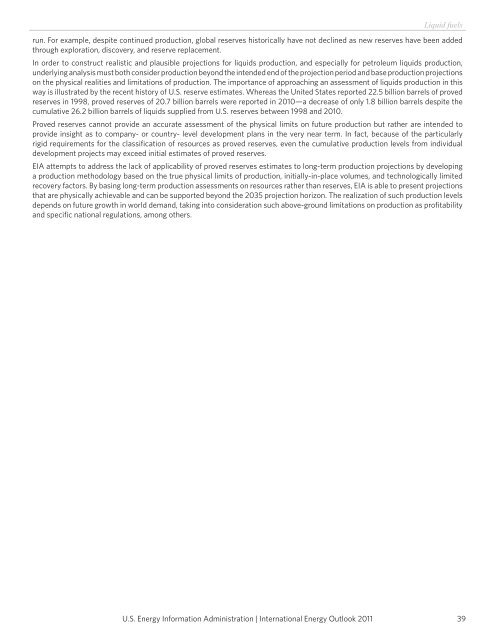U.S. <strong>Energy</strong> Information Administration | <strong>International</strong> <strong>Energy</strong> <strong>Outlook</strong> <strong>2011</strong> Liquid fuels run. For example, despite continued production, global reserves historically have not declined as new reserves have been added through exploration, discovery, and reserve replacement. In order to construct realistic and plausible projections for liquids production, and especially for petroleum liquids production, underlying analysis must both consider production beyond the intended end of the projection period and base production projections on the physical realities and limitations of production. The importance of approaching an assessment of liquids production in this way is illustrated by the recent history of U.S. reserve estimates. Whereas the United States reported 22.5 billion barrels of proved reserves in 1998, proved reserves of 20.7 billion barrels were reported in 2010—a decrease of only 1.8 billion barrels despite the cumulative 26.2 billion barrels of liquids supplied from U.S. reserves between 1998 and 2010. Proved reserves cannot provide an accurate assessment of the physical limits on future production but rather are intended to provide insight as to company- or country- level development plans in the very near term. In fact, because of the particularly rigid requirements for the classification of resources as proved reserves, even the cumulative production levels from individual development projects may exceed initial estimates of proved reserves. <strong>EIA</strong> attempts to address the lack of applicability of proved reserves estimates to long-term production projections by developing a production methodology based on the true physical limits of production, initially-in-place volumes, and technologically limited recovery factors. By basing long-term production assessments on resources rather than reserves, <strong>EIA</strong> is able to present projections that are physically achievable and can be supported beyond the 2035 projection horizon. The realization of such production levels depends on future growth in world demand, taking into consideration such above-ground limitations on production as profitability and specific national regulations, among others. 39
Liquid fuels References for liquid fuels Links current as of July <strong>2011</strong> 42. U.S. <strong>Energy</strong> Information Administration, Short-Term <strong>Energy</strong> <strong>Outlook</strong> March <strong>2011</strong>, website www.eia.gov/steo/archives/mar11.pdf. 43. U.S. <strong>Energy</strong> Information Administration, Annual <strong>Energy</strong> <strong>Outlook</strong> 2010, DOE/<strong>EIA</strong>-0383(2010) (Washington, DC, April 2010), website www.eia.gov/forecasts/aeo/index.cfm. 44. “Sub-Saharan Africa: Frontier NOC Challenges,” PFC <strong>Energy</strong>: Horizons Service (April 7, 2010), website www.pfcenergy.com (subscription site); “World: <strong>Outlook</strong> <strong>2011</strong>: Boldly Striding Out to New Frontiers and Diversification,” PFC <strong>Energy</strong> (December 22, 2010), website www.pfcenergy.com (subscription site); “Uganda on road to breakthrough” (December 10, 2010), upstreamonline. com, website www.upstreamonline.com (subscription site); and “Ghana Celebrates as Jubilee Flows” (December 15, 2010), upstreamonline.com, website www.upstreamonline.com (subscription site). 45. “OPEC Output and Quotas—January <strong>2011</strong>,” PFC <strong>Energy</strong>: MIS Service (January 14, <strong>2011</strong>), website www.pfcenergy.com (subscription site); “Oil Falls Again,” Upstream (October 12, 2010), website www.upstreamonline.com (subscription site); and “OPEC: A Dangerous Complacency,” PFC <strong>Energy</strong> (December 9, 2010), website www.pfcenergy.com (subscription site). 46. “OPEC: Iraq Factor Complicates Decision-Making,” PFC <strong>Energy</strong> (October 12, 2010), website www.pfcenergy.com (subscription site); P. Mackey et al., “Export Problems May Crimp Iraq Spending,” <strong>International</strong> Oil Daily, Vol. 10, No. 55 (March 18, <strong>2011</strong>), pp. 1-2 ; and “Expectations Lowered for Crude Output” (December 3, 2010), upstreamonline.com, website www.upstreamonline. com (subscription site). 47. “Tupi Oil Field, Brazil” (2010), offshore-technology.com, website www.offshore-technology.com/projects/tupi. 48. T. Rhodes and I. Londres, “Brazil: Proposals for a New Petroleum Regime in Brazil,” Mondaq, Ltd. (September 10, 2009), website www.mondaq.com/article.asp?articleid=85774. 49. Agência Brasil, “ANP: Consumo de Álcool Combustível é 50% Maior em 2007,” Terra Networks Brasil (July 15, 2008), website http://economia.terra.com.br/noticias/noticia.aspx?idNoticia=200807152306_ABR_77211977. 50. B. Radowitz, “Pre-Salt to Make Brazil’s Reserves World’s 9th Biggest,” RIGZONE (November 24, 2008), website www.rigzone. com/news/article.asp?a_id=69936. 51. IHS Global Insight, “Brazil: Petrobras Declares Commerciality at Pre-Salt Field” (January 4, <strong>2011</strong>), website www.ihsglobalinsight. com (subscription site). 52. J.S. Gabrielli and A. Barbassa (Petrobras), Business Plan 2010-2014 Webcast (2010), website www.petrobras.com. 53. J. Leahy, “Brazil: Platform for Growth,” Financial Times (March 15, <strong>2011</strong>), website www.ft.com (subscription site). 54. J. Kerr, IHS Global Insight, “Brazil: Petrobras’s Share Sale Will See Government Stake Increase,” (September 27, 2010), website www.ihsglobalinsight.com (subscription site). 55. E. Watkins, “Brazil Approves Oil Laws, Opens Pre-Salt Region for Development,” Oil & Gas Journal, Vol. 108, No. 47 (December 13, 2010), website www.ogj.com (subscription site). 56. T. Hennigan, “Brazil to Re-launch Bid Rounds This Year? Definitely Maybe,” Latin America Oil & Gas Monitor, Issue 352 (March 1, <strong>2011</strong>), website www.newsbase.com (subscription site). 57. “In Deep Waters,” The Economist (February 3, <strong>2011</strong>), website www.economist.com (subscription site). 58. T. Hennigan, “Skill Shortage Is Petrobras’ Next Big Hurdle to Overcome,” Latin America Oil & Gas Monitor, Issue 345 (January 11, <strong>2011</strong>), website www.newsbase.com (subscription site). 59. “KazTransOil and Transneft To Expand the Atyrau-Samara Pipeline,” Silk Road Intelligencer (July 10, 2008), website http:// silkroadintelligencer.com/2008/07/10/kaztransoil-and-transneft-to-expand-the-atyrau-samara-pipeline. 60. J. Kerr, “<strong>Energy</strong> Analysis: Ecuadorian President Presents Hydrocarbons Reform” (September 22, 2009), website www. ihsglobalinsight.com (subscription site). 61. U.S. Congress, <strong>Energy</strong> Independence and Security Act of 2007 (January 4, 2007), website http://frwebgate.access.gpo.gov/ cgi-bin/getdoc.cgi?dbname=110_cong_bills&docid=f:h6enr.txt.pdf. 62. T.W. Hertel, W.E. Tyner, and D.K. Birur, “The Global Impacts of Biofuel Mandates,” <strong>Energy</strong> Journal, Vol. 31, No. 1 (2010), pp. 75- 100, website www.iaee.org/en/publications/journal.aspx (subscription site). 63. F.O. Licht, “Germany: Government To Lower 2009 Biofuels Quota,” World Ethanol & Biofuels Report, Vol. 7, No. 3 (October 8, 2009), p. 55, website www.agra-net.com (subscription site). 64. “Worldwide Look at Reserves and Production,” Oil & Gas Journal, Vol. 106, No. 46 (December 6, 2010), pp. 47-48, website www.ogj.com (subscription site). 40 U.S. <strong>Energy</strong> Information Administration | <strong>International</strong> <strong>Energy</strong> <strong>Outlook</strong> <strong>2011</strong>

















